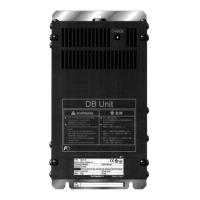1.3 Precautions for Using Inverters
1-8
1.3.3 Precautions for connection of peripheral equipment
[ 1 ] Phase-advancing capacitors for power factor correction
Do not mount a phase-advancing capacitor for power factor correction in the inverter's input (primary) or output
(secondary) circuit. Mounting it in the input (primary) circuit takes no effect. To correct the inverter power factor, use
an optional DC reactor (DCR). Mounting it in the output (secondary) circuit causes an overcurrent trip, disabling
operation.
An overvoltage trip that occurs when the inverter is stopped or running with a light load is assumed to be due to
surge current generated by open/close of phase-advancing capacitors in the power system. An optional DC/AC
reactor (DCR/ACR) is recommended as a measure to be taken at the inverter side.
Inverter input current to an inverter contains harmonic components that may affect other motors and
phase-advancing capacitors on the same power supply line. If the harmonic components cause any problems,
connect a DCR/ACR to the inverter. In some cases, it is necessary to insert a reactor in series with the
phase-advancing capacitors.
[ 2 ] Power supply lines (Application of a DC/AC reactor)
Use a DC reactor (DCR) when the capacity of the power supply transformer is 500 kVA or more and is 10 times or
more the inverter rated capacity or when there are thyristor-driven loads. If no DCR is used, the
percentage-reactance of the power supply decreases, and harmonic components and their peak levels increase.
These factors may break rectifiers or capacitors in the converter section of the inverter, or decrease the
capacitance of the capacitors.
If the input voltage unbalance rate is between 2% and 3%, use an optional AC reactor (ACR).
67 ×
(V) voltage average phase-Three
(V) voltage Min. - (V) voltage Max.
=(%) unbalance Voltage
(IEC/EN61800 - 3)
[ 3 ] DC reactor (DCR) for correcting the inverter input power factor
(for suppressing harmonics)
To correct the inverter input power factor (to suppress harmonics), use a DCR. Using a DCR increases the
reactance of inverter’s power source so as to decrease harmonic components on the power source lines and
correct the power factor of the inverter.
DCR models Input power factor Remarks
DCR2/4-/A/B Approx. 90% to 95% The last letter identifies the capacitance.
DCR2/4-C Approx. 86% to 90%
Exclusively designed when applying with motors with a
rated capacity of 37 kW or above.
• Select a DCR matching not the inverter capacity but the rated capacity of the applied motor. Applicable
reactors differ depending upon the selected ND, HD, HND or HH
D mode even on the same type of
For applied motors of 75 kW or above, be sure to connect a DCR to the inverter.
[ 4 ] PWM converter for correcting the inverter input power factor
Using a PWM converter (High power-factor, regenerative PWM converter, RHC series) corrects the inverter power
factor up to nearly “1.”
When combining an inverter with a PWM converter, disable the main power down detection by setting the function
code H72 to “0” (default). If the main power down detection is enabled (H72 = 1, factory default), the inverter
interprets the main power as being shut down, ignoring an entry of a run command.

